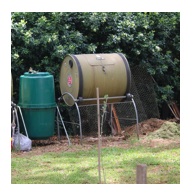 Compost is one of the best fertilisers you can use on your vegetable garden.
Compost is one of the best fertilisers you can use on your vegetable garden.
It’s cheap, it recycles waste and often local councils will give you some monetary incentive to buy one, some even give them away for free.
There are so many different ones: bins, bays, barrels, piles, tumblers, heaps and containers; with so many choices, it’s hard to know which one to choose for the best compost.
Before you decide on what to choose, you’ll have to ask yourself a few more questions.
How quickly do I want my compost? 6 weeks or 6 months?
How much room do I have?
How much waste do I have access to?
How much compost do I want?
Am I going to bother turning it every week?
All of these things influence what method of composting you choose.
In any compost heap it’s important to layer alternating dry materials (e.g. carbon rich straw or sawdust) and wet materials (e.g. nitrogen rich kitchen scraps or grass clippings) for successful breakdown into nutrient rich humus.
The method you choose is all about what choices you have in housing your compost rather than looking at the technique of constructing layers of different materials. This comes down to whether you use aerobic composting or anaerobic composting.
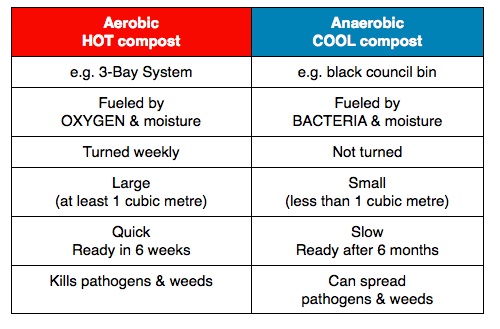
Aerobic compost
In this method of composting, oxygen fuels the decomposition process and heat breaks down the materials. This compost generates heat from it’s own internal energy, often it gets to over 60oC and this heat will kill off many pathogens and weed seeds. The other bonus is that it can be ready to use in a couple of months. The drawback (yes, there’s always a catch) is that it needs to be at least 1 cubic metre to build enough internal energy. Now that’s pretty big, so you’re going to need enough room in your backyard or community garden to create this monster compost maker.
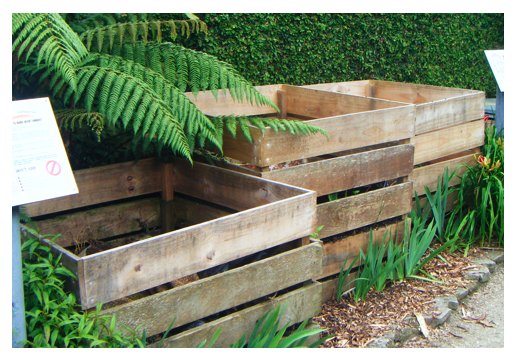
The other drawback is that it needs to be turned. Breakdown occurs rapidly for the first few days but when the oxygen is used up the compost starts to cool down and decomposition slows. So to crank it back up again, we inject a new dose of oxygen into the compost by turning it, once a week. The compost heats up again, reaching a peak within 3 or 4 days and then cools down until it is turned again. A bay system with 2 or 3 compartments (each 1 cubic metre capacity) allows you to turn the compost into a new spot each time you turn it (it will reduce in overall size each time until it is only about a third of the original size).
Here’s an example of this method in one community garden. It uses old fence palings to create the bays. Removable panels at the front can make it more accessible for turning.
Anaerobic compost
This compost is not fuelled by oxygen but instead depends on bacteria to do the job of decomposition. After the compost is made and once the available oxygen is used up, usually after about a week, then the compost becomes anaerobic if it is left to rot down naturally and not turned over.
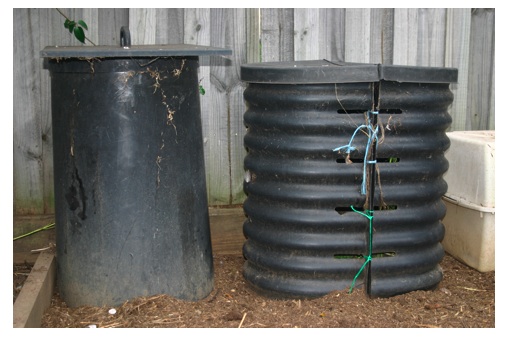
So in essence, any compost starts aerobically but, if left untouched and not turned, will become anaerobic. This is a slower process and doesn’t heat up as much so it can take more than 6 months to achieve. Generally small composts operate this way, this is why most black council bins commonly seen in many backyards, take so long to produce compost.
Consider your choices
Space
If you have lots of space, want lots of compost, have access to lots of waste material and want your compost fast then choose aerobic composting.
Waste & Turning
If you only have a small backyard, have small amounts of kitchen waste, only have a small garden bed to maintain and you can’t be bothered going to the effort of weekly turning, then choose anaerobic composting.
Speed
If you want something in between these two then simply turn your compost weekly to speed things up a bit. Alternatively, consider using a compost tumbler. These are costly but effective if used properly. The thing to remember is not to overfill them. These work on an aerobic system but don’t have the size to create enough internal energy, so you’ll need to turn the tumbler by cranking the handle once or twice a week. If it’s only about one-third full then it’s full of air and not too heavy to turn. The one on higher stilts can fit a wheel barrow below it for easy emptying.
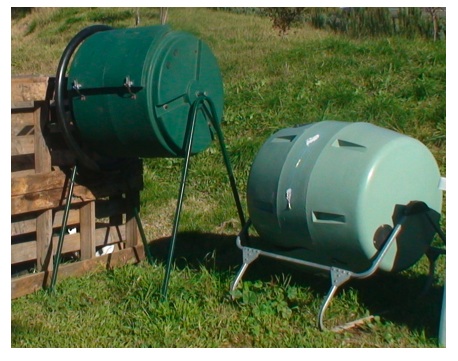
Now you have your choices, you know how to layer it effectively alternating with carbon and nitrogen rich materials and hopefully you’ve chosen the right bin for your circumstances. So have a go!! With time and persistence you’ll have it just perfect.




 Twitter
Twitter Facebook
Facebook